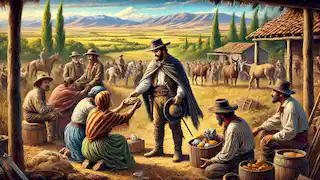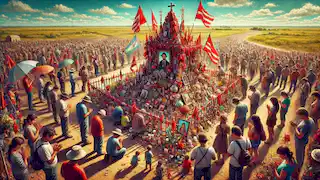Chapter 1: The Beginning of a Legend
In the heart of Argentina's sprawling pampas, where the horizon stretches endlessly and the whispering winds carry tales of old, a legend was born. Antonio Mamerto Gil Núñez, known to the world as Gauchito Gil, emerged as a beacon of hope and defiance in a time of turmoil.
Antonio was born in the small town of Mercedes, Corrientes, during a period of great unrest in Argentina. The land was rife with conflicts between the federalists and the unitarians, with the common folk often caught in the crossfire. From a young age, Antonio displayed an uncommon sense of justice and an unwavering spirit. His parents, humble farmers, taught him the value of hard work and integrity, but it was clear that Antonio was destined for something greater.
As Antonio grew, so did his reputation. Known for his kindness and bravery, he often intervened in local disputes, ensuring that the weak were protected from the powerful. His deep connection to the land and its people earned him the nickname "Gauchito," a term of endearment for the rural cowboys of Argentina.
One fateful day, the town was visited by a group of federalist soldiers, seeking to conscript young men into their ranks. Antonio, unwilling to fight in a war he did not believe in, fled into the wilderness. This act of defiance marked the beginning of his life as an outlaw, but also the start of his transformation into a folk hero.
Chapter 2: The Outlaw with a Heart
Antonio roamed the pampas, evading capture and helping those in need. He quickly became a symbol of resistance against the oppressive forces of the time. Stories of his deeds spread like wildfire – how he robbed from the rich to give to the poor, healed the sick with his knowledge of local herbs, and stood up against corrupt officials.
Despite his outlaw status, Antonio never forgot his roots. He often returned to his hometown under the cover of night, visiting his family and aiding his community. The townspeople, in turn, protected him, providing shelter and supplies whenever he needed. To them, he was more than a fugitive; he was their protector and savior.
As his legend grew, so did the myths surrounding him. Some said he had the power to control the weather, others claimed he could disappear at will. Antonio did nothing to dispel these rumors, understanding that they only added to his mystique and protected him from his enemies.

Chapter 3: A Betrayal and a Miracle
Antonio's luck, however, could not last forever. Betrayed by a former ally, he was captured by federalist soldiers and sentenced to death. The night before his execution, Antonio had a vision. The Virgin Mary appeared to him, telling him that he would be remembered as a saint and that his death would bring about miracles.
The next morning, Antonio faced his executioners with unwavering calm. As the executioner raised his blade, Antonio's final words were a plea for his killers: "You will shed innocent blood, but there will be no rest for you. When your son falls ill, remember this moment and pray to me for forgiveness."
With those words, the blade fell, and Antonio's life was ended. Yet, it was not the end of his story. The executioner returned home to find his son gravely ill. Desperate and guilt-ridden, he remembered Antonio's words and prayed for his forgiveness. Miraculously, his son recovered, and word of this event spread quickly.

Chapter 4: The Birth of a Saint
Antonio's grave became a pilgrimage site, with people traveling from far and wide to seek his aid. They believed that Gauchito Gil had been blessed with the power to intercede on their behalf, performing miracles from beyond the grave. The simple cross marking his burial place was soon surrounded by offerings and tokens of gratitude.
Over the years, the legend of Gauchito Gil grew, cementing his status as a folk saint. Devotees constructed shrines in his honor, adorning them with red flags – the color of the federalists who had taken his life, now a symbol of his martyrdom and sacrifice. Pilgrims came to these shrines with prayers and hopes, leaving behind plaques and notes of thanks for the miracles they believed he had granted.
Despite the Catholic Church's initial reluctance to recognize his sainthood, the devotion of the people could not be ignored. Gauchito Gil became an integral part of Argentina's cultural and spiritual landscape, a testament to the enduring power of hope and faith.

Chapter 5: The Legacy Lives On
Today, Gauchito Gil's story continues to inspire. His shrines can be found along roadsides and in the hearts of cities, each one a testament to the lives he touched and the miracles attributed to him. Pilgrims still gather, sharing stories of their own encounters with the saint, each tale adding another layer to the rich tapestry of his legend.
In the modern age, Gauchito Gil stands as a symbol of resistance against injustice and the enduring power of compassion. His life and legacy remind us that even in the darkest times, there is light to be found in acts of kindness and bravery. His story is a bridge between the past and the present, a reminder that legends are born from the lives of those who dare to stand up for what is right.

Epilogue: A Timeless Legend
The legend of Gauchito Gil is more than just a story; it is a reflection of the human spirit's capacity for resilience and benevolence. It speaks to the power of an individual's actions to transcend time and space, leaving an indelible mark on the world. As long as there are those who remember and honor his name, Gauchito Gil will live on, a guardian angel of the pampas, watching over the land and its people.



















